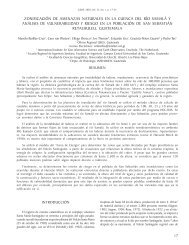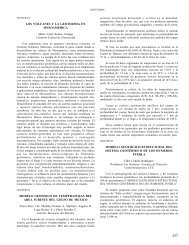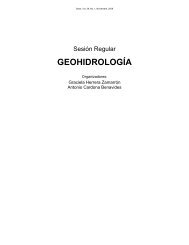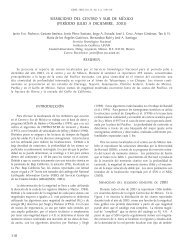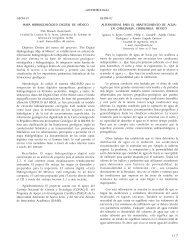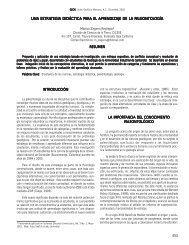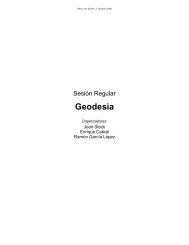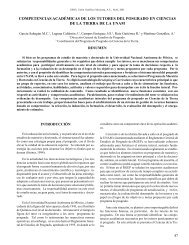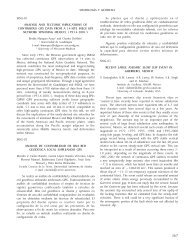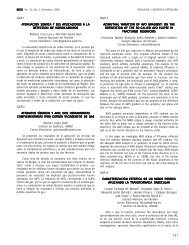Libro de resúmenes - Unión Geofisica Mexicana AC
Libro de resúmenes - Unión Geofisica Mexicana AC
Libro de resúmenes - Unión Geofisica Mexicana AC
You also want an ePaper? Increase the reach of your titles
YUMPU automatically turns print PDFs into web optimized ePapers that Google loves.
G-GAP (THE GUERRERO SEISMIC GAP): NEW INSIGHTS OF THE SEISMICCYCLE, EPISODIC ASEISMIC SLOW SLIPS AND NONVOLCANIC...Geos, Vol. 31, No. 1, Noviembre, 2011SE11-10DETECTING LOW-FREQUENCY EARTHQUAKES WITHINNON-VOLCANIC TREMOR IN GUERRERO, MEXICOShapiro Nikolai 1 , Frank William 1 , Kostoglodov Vladimir 2 , Husker Allen 2 y Campillo Michel 31 Institut <strong>de</strong> Physique du Globe <strong>de</strong> Paris, France2 Instituto <strong>de</strong> Geofísica, UNAM3 Institut <strong>de</strong>s Sciences <strong>de</strong> la Terre, UJF, Francenshapiro@ipgp.frWe use the seismograms recor<strong>de</strong>d by stations of the Meso-American SeismicExperiment (MASE) network to study the Non-Volcanic Tremors (NVT) occurringin the Guerrero region with a particular interest to <strong>de</strong>tect Low FrequencyEarthquakes (LFE). We show that the NVT records sometimes contain withinthem a series of smaller seismic events with a multiplet behavior. It is possibleto pick an impulsive waveform within a tremor burst, referred to as the template,and find a set of similar events that make up an event family by correlatingthe template with available data. When stacked, this family reveals a coherentphase from a seismic event. The motions are the strongest along the horizontalcomponents and when compared to synthetic seismograms, correlate extremelywell with the S wave arrivals. Focal mechanisms of the i<strong>de</strong>ntified templatefamilies are close to nearly horizontal inverse faulting reflecting the geometry ofthe subduction interface. Further precision of locations and of focal mechanismsof these LFEs are expected to help us to better un<strong>de</strong>rstand the physics of theslow <strong>de</strong>formation in the Mexican subduction zone.SE11-11A NEW LOCATION TECHNIQUE FOR NON VOLCANICTREMORS AND LOW FREQUENCY EARTHQUAKESCruz-Atienza Víctor M., Legrand Denis, Kostoglodov Vladimir y Husker AllenInstituto <strong>de</strong> Geofísica, UNAMcruz@geofisica.unam.mxDo the slab fluids inferred in the Guerrero province may migrate duringsuccessive slow slip earthquakes (SSE) into the continental crust? and, ifso, which implications would be in terms of non volcanic tremor (NVT)triggering? Reliable evi<strong>de</strong>nce of NVT hypocentral locations above the platesinterface (i.e. within the <strong>de</strong>ep and intermediate continental crust) would becritical to constrain and support a given mo<strong>de</strong>l relating the silent earthquakesphenomenology. To this end, we present NVT and low frequency earthquakes(LFE) relocations during the 2006 SSE time span with a new and promisingtechnique (Cruz-Atienza et al., 2011). This technique is based on NVTenergy-like and waveform correlation measurements in the three ground motioncomponents. By means of a source-scanning grid search, and a large databaseof both synthetic seismograms and theoretical arrival times computed withray tracing, the algorithm looks for the hypocentral locations that minimizean error function between observed and synthetic energy-like profiles, andboth P- and S-waveform correlations. We test the algorithm by locating bothfinite-difference synthetic NVTs (Cruz-Atienza, 2010) and the whole NVTcatalogue (more than 250 events) introduced by Husker et al. (G.Int., 2010)for the Guerrero province during the period of interest. Our locations firstconfirm the horizontal segmentation of the NVT activity during the 2006 SSEpreviously reported (Payero et al., 2008; Husket et al., 2011). Secondly, the NVTactivity triggered during such SSE seems to be localized in the middle crust(~20 km <strong>de</strong>pth), <strong>de</strong>finitively above the plate interface (~40 km <strong>de</strong>pth), whereanomalous non-linear crustal behavior has been suggested (Rivet et al., 2011).This behavior, which promotes shear failure and is enhanced in the presenceof fluids, is an attractive candidate to explain, at least partly, the NVT triggeringassociated with quasi-static SSE crustal <strong>de</strong>formation.SE11-12LOW FREQUENCY EARTHQUAKES LOCATIONS IN GUERRERO, MEXICONovo Obrador Garrido Ximena y Husker AllenInstituto <strong>de</strong> Geofísica, UNAMximenanog@gmail.comIn recent years, many low#frequency earthquakes (LFEs) has been discoveredworldwi<strong>de</strong>. The low-frequency earthquakes or LFEs occur almost exclusivelyas part of a non-volcanic tremor (NVT) signal. The NVT and the LFEs arelocated approximately in the same region and exhibit similar behavior [Obaraet al., 2002, 2004, 2006]. It is not known if the LFEs and NVT representthe same phenomena, its close association means that their mechanisms areprobably linked. The non-volcanic tremors (NVT) was first time i<strong>de</strong>ntified in theNankai subduction zone, southwestern Japan, later observed in the Cascadiasubduction zone, Alaska, Costa Rica, as well as subduction zone of Guerreroin Mexico. These non-volcanic tremors have been explained as a swarm oflow-frequency earthquakes [Shelly et al., 2006, 2007]. For this reason thelocation of the LFEs could give us a better un<strong>de</strong>rstanding of the area where theNVT occur in Mexico and obtain more precise locations of these phenomena.Here we presented a catalog of the LFEs in the non-volcanic tremors and theirlocations for the period from 2005 to 2007. To i<strong>de</strong>ntify the LFEs we filteredthe signal between 1 and 8 Hz, and we find the better events for the largestnumber of stations for make a better location. The data used correspond tothe the broadband records of the project MASE (Middle America SubductionExperiment) stations.SE11-13COMPLEX RELATIONS BETWEEN SLOW SLIPEVENTS, NON-VOLCANIC TREMORS, AND SEISMICWAVE VELOCITY CHANGES IN GUERRERO MEXICORivet Diane 1 , Zigone Dimitri 1 , Campillo Michel 1 , Cruz-AtienzaVíctor M. 2 , Radiguet Mathil<strong>de</strong> 1 , Shapiro Nikolai 3 y Husker Allen 21 Institut <strong>de</strong>s Sciences <strong>de</strong> la Terre, UJF, France2 Instituto <strong>de</strong> Geofísica, UNAM3 Institut <strong>de</strong> Physique du Globe <strong>de</strong> Paris, Francediane.rivet@obs.ujf-grenoble.frOver the last 6 years an important effort has been done in geo<strong>de</strong>tic andseismic instrumentation of the Guerrero subduction zone e.g. the MASE seismicexperiment (from 2005 to 2007) and the GGAP project, both a seismic and ageo<strong>de</strong>tic experiments (from 2009 to 2011). Analyzing these continuous geo<strong>de</strong>ticand seismic recordings, we observe non-volcanic tremors (NVT) activities andseismic velocity changes during two large slow slip events (SSE) sequencesin 2006 and 2009-2010. Here we propose to compare the occurrence in timeand space of SSEs, NVTs, seismic velocity changes and seismicity over the twolast SSEs in or<strong>de</strong>r to better un<strong>de</strong>rstand the complex mechanical behavior of thesubduction zone in this region.A perturbation of the mechanical properties of rocks within the Earth’s crusthas been recently observed from the observation of a velocity perturbationassociated with quasi-static <strong>de</strong>formation at <strong>de</strong>pth produced by the 2006 SSE(Rivet et al. 2011). This velocity perturbation maximizes in the middle crust at20km <strong>de</strong>pth. Similarly we observe a velocity <strong>de</strong>crease during the 2009-2010SSE. This last SSE presents two distinctive slipping patches (Walpersdorf etal, 2011). The velocity drop is greater at the time of the first subevent, whichoccurred below the seismic array, than at the time of the second subevent.During the 2006 SSE, Kostoglodov et al. (2010) and Husker et al. (in prep))observe an increase in NVT activity. Using the slip mo<strong>de</strong>l that <strong>de</strong>scribes theslip evolution during the SSE (Radiguet et al., 2010) we observe that the NVTsfollow the slip front where the shear stress maximizes. However other NVTsburst are observed outsi<strong>de</strong> the SSEs period and are not associated with SSEsor velocity changes. Only one of these bursts in 2005 is clearly associated toa small SSE <strong>de</strong>tected on geo<strong>de</strong>tic measurement and a velocity drop. Theseobservations suggest a rather complex relation between slow slip and NVTsactivity.Zigone et al. 2011 show that an NVTs sequence and the second subevent ofthe 2009-2010 SSE were triggered by the 2010 Maule earthquake (Mw 8.8). Weinvestigate the relation of other large teleseismic earthquakes with NVTs andSSEs from 2005 to 2011. No other large teleseismic event triggered NVT or slip.This suggests that the dynamic triggering of NVTs and slip is <strong>de</strong>pen<strong>de</strong>nt of thestate of stress of the subduction interface.The relation between the seismic velocity perturbation and the strain due tothe SSEs suggests that the <strong>de</strong>formation of the overlying crust shows significantnonlinear elastic behavior. NVTs could be as well produced by the <strong>de</strong>formationand related to this nonlinear elastic behavior of the overlying crust. Howeverprecise location of NVTs at <strong>de</strong>pth is nee<strong>de</strong>d to be conclusive about the relationbetween velocity changes and NVTs.SE11-14CRUSTAL TRAVEL-TIME TOMOGRAPHY BELOW SOUTHERN MEXICOHuesca Pérez Eduardo y Husker AllenInstituto <strong>de</strong> Geofísica, UNAMehuesca@gmail.comP and S wave travel-time tomographies as well as a Vp/Vs ratio image of thecrust below southern Mexico were <strong>de</strong>veloped using data from the MesoAmericanSubduction Experiment (MASE) broad band temporary network. A 2-D raytracing pseudo-bending algorithm was employed and a damped least-squaremethod to perform the inversions. The profiles have their origins at the Pacificcoast and run 205 km inland perpendicular to the trench and sample the crustand the subducted Cocos slab. Results show fast velocities to the south of 40km over the <strong>de</strong>scending section of the slab, a low P-wave anomaly just wherethe slab bends to become subhorizontal and low velocities above the slab northof 100 km from the coast for both waves. The Vp/Vs image show two areas withhigh values south of 60 km where the slab <strong>de</strong>scends and between 90 – 140 kmfrom the coast indicating the presence of fluids in the NVT (Non-Volcanic Tremor)zone; low values where the slab bends indicating that the zone is dominated by180



![Libro de resúmenes [revisión final, 172 páginas] - UGM](https://img.yumpu.com/51565067/1/190x245/libro-de-resamenes-revisian-final-172-paginas-ugm.jpg?quality=85)
